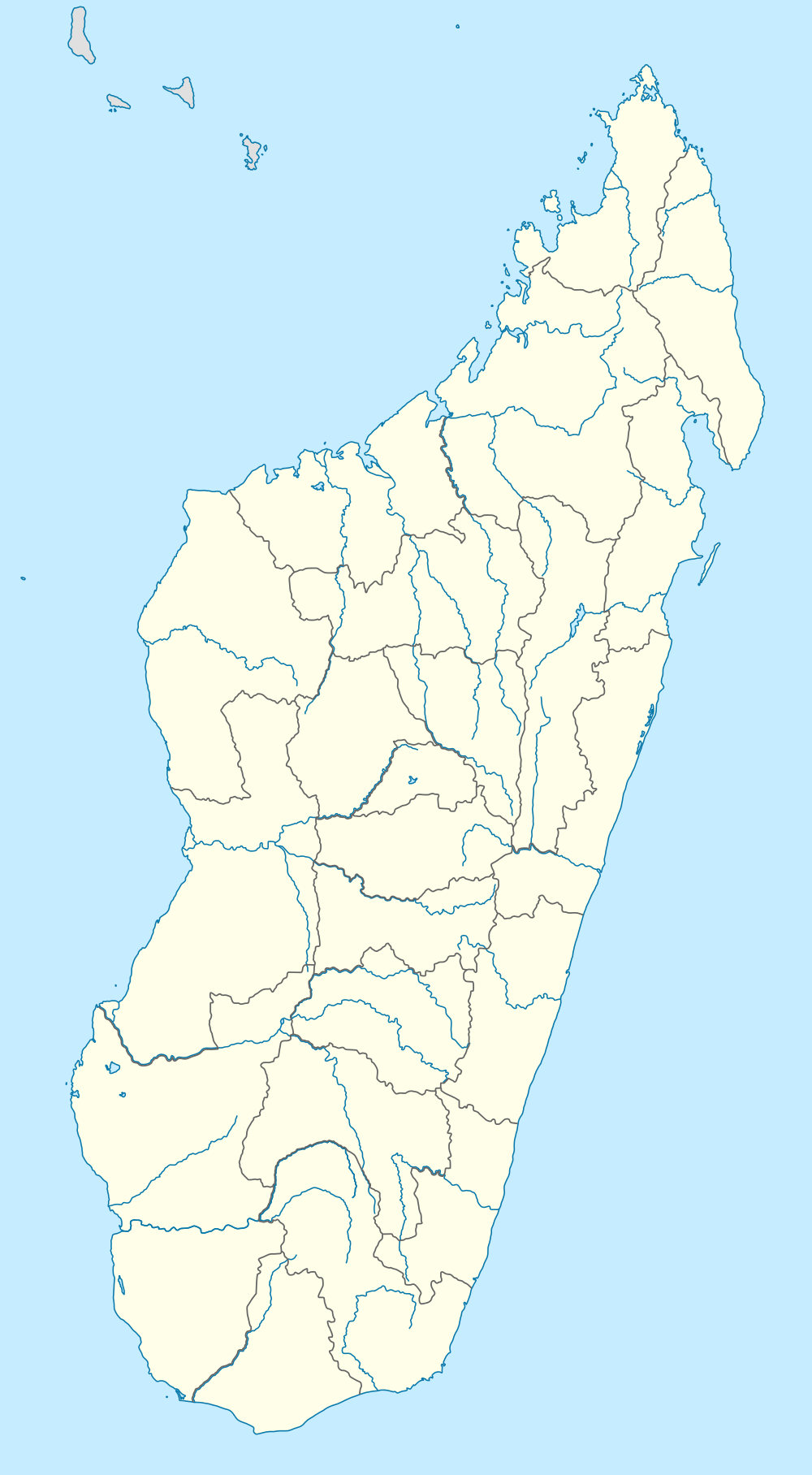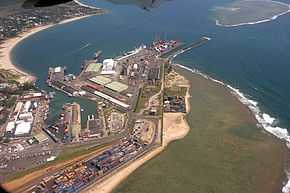Toamasina
| Toamasina Tamatave | |
|---|---|
|
Toamasina | |
 Toamasina Location in Madagascar | |
| Coordinates: 18°09′S 49°25′E / 18.150°S 49.417°E | |
| Country |
|
| Region | Atsinanana |
| Population (2001) | |
| • Total | 179,045 |
| Time zone | EAT (UTC3) |
Toamasina [toˈmasinə̥], meaning "like salt" or "salty", unofficially and in French also Tamatave, is the capital of the Atsinanana region on the east coast of Madagascar on the Indian Ocean. The city is the chief seaport of the country, situated 215 km (134 mi) northeast of its capital and biggest city Antananarivo, near the centre of the eastern coast at 18 10 S, 49 32 E. According to the 2001 census, Toamasina had a population of 179,045. The city is served by Toamasina Airport.
Overview
Toamasina owes its importance to the existence of a coral reef which forms a spacious and fairly commodious harbour, entered by two openings. The city center is built on a sandy peninsula which projects at right angles from the general coastline. On this are crowded together a considerable number of houses, with shops and merchant offices located in the main thoroughfares.

The city has wide palm tree-lined avenues and a wide selection of hotels and restaurants. The beaches in this area are famously beautiful, although sharks and pollution often prevent swimming and watersports. Bazary Be is a famous colorful street market, specailizing in exotic spices and locally made handicrafts. The central market in the heart of the city is one of the most popular sites in the city.
The city is home to the University of Toamasina, which is part of Madagascar's public university system. Toamasina is also the see city of the Roman Catholic Archdiocese of Toamasina. Gervais Rakotomanana is the president of the city by special delegation since 30 May 2007. The former mayor, Roland Ratsiraka, was suspended after a decision in the municipal council in early 2007.
Under French domination, Toamasina was the seat of several foreign consuls, as well as of numerous French officials, and was the chief port for the capital and the interior. Imports consisted principally of piece-goods, farinaceous foods, and iron and steel goods, and exports of gold dust, raffia, hides, caoutchouc (rubber) and live animals. Communication with Europe was maintained by steamers of the Messageries Maritimes and the Havraise companies, and also with Mauritius, and thence to Sri Lanka, by the British Union-Castle Line.[1]
During the colonial period owing to the character of the soil and the formerly crowded native population, the town was often attacked by epidemics: the plague broke out in 1898, and again in 1900; but since the draining of the neighboring marshes, there was an improvement. After 1895 the native population was removed from the town and settled in a new village to the north-west.[1]
Toamasina is the seat of the Roman Catholic Diocese of Toamasina.
Transport
The town is the railhead for the line to the capital. Pousse-Pousse are available throughout Toamasina to get around the city. Toamasina is the northern end of the Canal des Pangalanes.
Climate
Toamasina features a tropical rainforest climate under the Köppen climate classification. While Toamasina has no true dry season month where less than 60 mm (2.4 in) of precipitation (on average) falls, the seaport has noticeably wetter and drier periods of the year. September–November is the driest period of the year, while February–April is the wettest time of the year. Average temperatures are relatively constant throughout the course of the year, though it is slightly cooler in the months of July and August, where average highs hover around 24 degrees Celsius and warmer in the months of January and February, where high temperatures on average reaches 30 degrees Celsius. Toamasina averages roughly 3,250 mm (10 ft 8.0 in) of precipitation annually.
| Climate data for Toamasina | |||||||||||||
|---|---|---|---|---|---|---|---|---|---|---|---|---|---|
| Month | Jan | Feb | Mar | Apr | May | Jun | Jul | Aug | Sep | Oct | Nov | Dec | Year |
| Record high °C (°F) | 37 (99) |
35 (95) |
36 (97) |
33 (91) |
30 (86) |
28 (82) |
28 (82) |
27 (81) |
29 (84) |
30 (86) |
32 (90) |
35 (95) |
37 (99) |
| Average high °C (°F) | 30.1 (86.2) |
30.0 (86) |
29.3 (84.7) |
28.4 (83.1) |
26.7 (80.1) |
25.1 (77.2) |
24.3 (75.7) |
24.4 (75.9) |
25.5 (77.9) |
26.9 (80.4) |
28.5 (83.3) |
29.5 (85.1) |
27.4 (81.3) |
| Average low °C (°F) | 23.1 (73.6) |
23.1 (73.6) |
22.8 (73) |
21.8 (71.2) |
20.0 (68) |
18.4 (65.1) |
17.6 (63.7) |
17.5 (63.5) |
18.0 (64.4) |
19.0 (66.2) |
20.9 (69.6) |
22.3 (72.1) |
20.4 (68.7) |
| Record low °C (°F) | 21 (70) |
21 (70) |
20 (68) |
19 (66) |
17 (63) |
14 (57) |
15 (59) |
13 (55) |
15 (59) |
16 (61) |
17 (63) |
19 (66) |
13 (55) |
| Average rainfall mm (inches) | 391 (15.39) |
404 (15.91) |
498 (19.61) |
308 (12.13) |
263 (10.35) |
264 (10.39) |
262 (10.31) |
211 (8.31) |
126 (4.96) |
91 (3.58) |
185 (7.28) |
287 (11.3) |
3,290 (129.52) |
| Avg. rainy days (≥ 1.0 mm) | 19 | 17 | 21 | 18 | 17 | 18 | 22 | 20 | 15 | 13 | 14 | 17 | 211 |
| Average relative humidity (%) | 83 | 83 | 85 | 84 | 85 | 85 | 84 | 85 | 83 | 82 | 83 | 84 | 83.8 |
| Mean monthly sunshine hours | 217.0 | 192.0 | 182.9 | 195.0 | 201.5 | 168.0 | 173.6 | 186.0 | 216.0 | 248.0 | 249.0 | 248.0 | 2,477 |
| Source #1: Weltwertter Spiegel Online [2] | |||||||||||||
| Source #2: BBC Weather [3] | |||||||||||||
See also
International relations
Twin towns — Sister cities
Toamasina is twinned with:
The city of Holon used to have a street named Tamatave Street (רחוב טמטב), named so in the sixties when Israel had warm relations with Madagascar. After the assassination of Rehav'am Ze'evi In the 2000s, the street was renamed after him.
Notes
- ↑ 1.0 1.1 Chisholm 1911, p. 387.
- ↑ "Wetter im Detail: Klimadaten". Spiegel Online.
- ↑ "Average Conditions Toamasina, Madagascar". BBC Weather. Retrieved July 17, 2010.
- ↑ Le Port est jumelé à quatre villes portuaires (French)
References
 This article incorporates text from a publication now in the public domain: Chisholm, Hugh, ed. (1911). "Tamatave". Encyclopædia Britannica 26 (11th ed.). Cambridge University Press. p. 387.
This article incorporates text from a publication now in the public domain: Chisholm, Hugh, ed. (1911). "Tamatave". Encyclopædia Britannica 26 (11th ed.). Cambridge University Press. p. 387.
External links
| Wikivoyage has a travel guide for Toamasina. |
- Map
- (French) University of Toamasina
- (French) Regional Tourist information office - Toamasina
- (French) Regional Harbour of Toamasina
- (French) Committee of development of the city of toamasina
